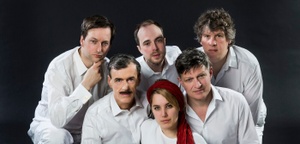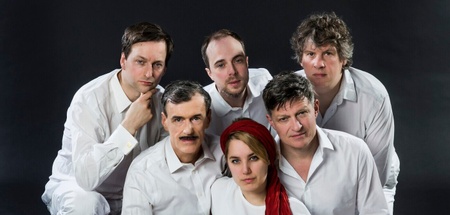DIE AUTO-PERFORATIONS-ARTISTEN (F.A.Q.)
In the organizer's words:
THE AUTO-PERFORATION ARTISTS (F.A.Q.)
Micha Brendel, Else Gabriel, Rainer Görß and Via Lewandowsky
curated by Stephan Koal
KVOST's exhibition is dedicated to the work of the Auto-Perforations-Artists. The group of artists, founded at the HfbK Dresden, has been active since 1982 and consisted of Micha Brendel (*1959), Else Gabriel (*1962), Rainer Görß (*1960) and Via Lewandowsky (*1963). This is the group's first institutional solo exhibition in Berlin.
Auto-Perforations-Artistik is a specific art form that combines performances, installations, music and actions. It developed in opposition to the prevailing dogmatically prescribed state culture and the art production of the GDR, which was oriented towards Socialist Realism. At the center of the auto-perforation artists' work was their own body, which was used to the point of self-harm.
KVOST shows Super 8 films, photographs and video recordings of performances as well as texts and concepts of the group as contemporary testimonies. In addition, documents of the surveillance and targeted measures of subversion by the State Security will be shown. The exhibition contrasts the accusations and insinuations contained therein with the artists' actual actions. For the first time since the beginning of 1989, the installation Umkleide can also be seen, now as a remake, then part of the exhibition Menetekel.
Menetekel was conceived for the Galerie Nord in Dresden as an associative parcours between comedy and dreariness and reflected the increasingly absurd everyday life in the late GDR. The artworks included cattle's lower legs from the slaughterhouse, glued to broken glass and placed in the rooms as the remains of a herd heading for the exit. On the walls, wallpaper surfaces mounted behind glass in a museum-like manner, carefully removed from an abandoned old apartment. A heavy-duty electromagnet, clocked by a timer, rattles as it pulls a sheet of metal from a cushion and lets it fall again.
The installation Umkleide plays with the ubiquitous "red light irradiation" in the GDR, instructions and slogans with which the superiority of socialism was upheld to the end, in striking contrast to reality. The ensemble was completed by a small generator that produced a continuous sinus tone at a level that children and dogs would find painful, but older people often no longer consciously perceive. The exhibition caused a political uproar and was temporarily closed by the city council's culture department for "hygienic reasons".
As an art form, performance was provocative in the GDR, as it offered the advantage of not having to fully disclose its content and meaning until the moment of performance and, on the other hand, left hardly anything material behind. This was one of the methods with which the auto-perforation artists managed to realize performances and exhibitions within the repressive structures of the GDR.
The titles of the actions, such as Langsam Nässen (1985), Spitze des Fleischbergs (1986), Midgard-Heldenhalden und Schaltkreismythologien (1989) or Von Ost nach Nord (01.07.1989), contained provocations that were recognizable to the public without being directly politically offensive.
By playing with ambiguities and the disturbing radicalism in their treatment of their own bodies, as well as their uncompromising attitude towards the established GDR art scene, the group quickly attracted a great deal of attention. Their enormous impact on the art scene in Berlin, Dresden and Leipzig is also thanks to some intrepid and curious art historians, above all Christoph Tannert. Today, the Auto-Perforations artists are among the most important performance groups of the 1980s.
The actions of the core group of Auto-Perforations artists were often expanded through collaborations with artist friends. Collaborators included, for example, the musicians Norbert Grandl, Gottfried Rösler and Ulf Wrede, the author Durs Grünbein, the dance teacher Hanne Wandtke, but also fellow students of the Dresden University of Fine Arts such as Karina Alisch, Peter Dittmer and Viola Schöpe.
The exhibition is the second part of a series at KVOST, which will show a group of artists who shaped the GDR for three consecutive years. The first part of this series was the exhibition of the Chemnitz artist group Clara Mosch in 2023.
This content has been machine translated.



